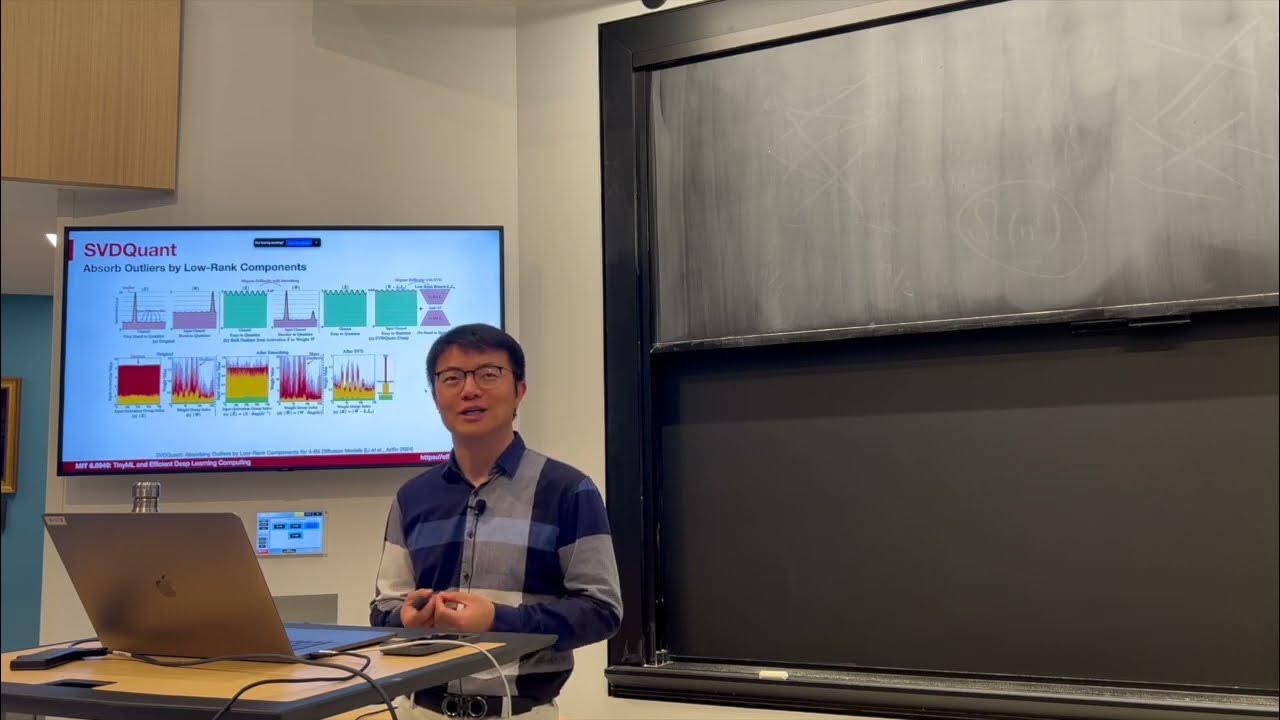DeepSeek on Apple Silicon in depth | 4 MacBooks Tested
Summary
TLDRThis video explores running large AI models on personal machines, focusing on challenges like memory limitations and the impact of quantization on performance. The presenter demonstrates how different quantization levels (2-bit, 4-bit, etc.) affect model output and speed, with a special emphasis on the hardware required to run massive models. They explain how to balance performance, memory capacity, and model size, sharing insights on running AI locally to maintain data privacy. The video provides a hands-on look at the technical aspects of AI model deployment on personal computers.
Takeaways
- 😀 Quantizing large models, like the 14 billion parameter model, can cause issues if done too much, leading to non-functional outputs.
- 😀 Models with excessive quantization levels, such as 2-bit or 1.5-bit, may produce very poor results, as seen with the AI not responding to requests.
- 😀 Despite limitations, large-scale quantization can still result in useful outputs, as demonstrated by DeepSeek R1 achieving decent results with a 1.5-bit quantized model.
- 😀 Hardware with at least 16 GB of RAM (like the MacBook Air M1) can run more quantized models without issue, especially when using 4-bit quantization.
- 😀 Models like the 70 billion parameter model can offer good balance between speed and accuracy, ideal for applications like coding and chat, if the hardware is sufficiently powerful.
- 😀 Running very large models (such as those in the 70 billion parameter range) locally requires a powerful setup, like a machine with 128 GB of RAM, for efficient operation.
- 😀 Cloud-based services should be avoided when running sensitive models, due to privacy concerns about sending data to servers in regions like China.
- 😀 The balance between model size, quantization level, and hardware memory capacity is critical for determining performance, including speed and stability.
- 😀 With 128 GB of RAM, larger models can be run at higher quantization levels (like 8-bit), providing high-quality output without slowing down significantly.
- 😀 Speed (tokens per second) may decrease slightly with larger models, but the output remains relatively stable and usable on personal machines with sufficient resources.
Q & A
What is the impact of quantization on AI models?
-Quantization reduces the size of AI models to make them more feasible to run on limited hardware. However, excessive quantization (e.g., 2-bit quantization) can lead to a model failing to produce output or losing functionality, as seen in the case of the 14 billion parameter model in the transcript.
Why does the speaker mention that models with higher parameter counts generally perform better?
-Larger models (with more parameters) tend to produce more accurate and detailed results because they can capture more complex patterns and information. However, they also require more computational power and memory, which can affect their speed and feasibility for personal hardware.
How does hardware affect the performance of large AI models?
-The hardware's memory (RAM) and processing power are crucial for running large models. Machines with higher RAM, like the M4 Max with 128GB, can handle larger models (e.g., 70 billion parameters) more effectively. In contrast, smaller machines with less RAM (e.g., 8GB MacBooks) can struggle with large models and need to rely on more aggressive quantization.
What is the role of the GPU in running large models?
-The GPU helps offload computational tasks from the CPU, especially for deep learning tasks. The speaker mentions offloading model layers to the GPU to handle more demanding AI models, improving speed and performance compared to using only the CPU.
What happens when trying to run a model that exceeds the machine's memory?
-When a model exceeds the available memory, it can cause errors or prevent the model from loading correctly, as seen when attempting to load the 131GB version of the model on a machine with only 128GB of RAM.
What is the significance of the 70 billion parameter model mentioned in the video?
-The 70 billion parameter model represents a large-scale AI model that strikes a balance between speed and accuracy. It offers better results for tasks like chat or coding but requires high computational power and RAM, such as the 128GB RAM in the M4 Max.
Why is the speaker cautious about using DeepSeek’s official website?
-The speaker advises against using DeepSeek’s official website because it involves sending data to servers in China, raising privacy concerns. Running models locally on personal machines helps protect user data.
What performance metrics are used to assess the output of AI models?
-Performance metrics like tokens per second are used to measure the speed of model output. In the transcript, the speaker highlights that the 70 billion parameter model outputs about 9 tokens per second, which is slower than desired but still functional for personal machines.
What is the trade-off between speed and output quality when running large models?
-Larger models generally produce better output quality but at the cost of speed. For example, the 70 billion parameter model provides more accurate results but operates at a slower pace (9 tokens per second), which might not be ideal for real-time applications.
What quantization levels are mentioned in the transcript, and how do they affect model performance?
-Quantization levels like 2-bit, 4-bit, and 8-bit are mentioned. Higher quantization levels reduce model size, making it easier to run on personal hardware, but they also decrease the model’s performance. The 2-bit version of a model, for example, can lead to the AI producing no output at all, while lower levels (4-bit, 8-bit) strike a balance between size and functionality.
Outlines

此内容仅限付费用户访问。 请升级后访问。
立即升级Mindmap

此内容仅限付费用户访问。 请升级后访问。
立即升级Keywords

此内容仅限付费用户访问。 请升级后访问。
立即升级Highlights

此内容仅限付费用户访问。 请升级后访问。
立即升级Transcripts

此内容仅限付费用户访问。 请升级后访问。
立即升级浏览更多相关视频

Optimize Your AI - Quantization Explained

1-Bit LLM: The Most Efficient LLM Possible?

EfficientML.ai 2024 | Introduction to SVDQuant for 4-bit Diffusion Models

Quantization: How LLMs survive in low precision

Ollama.ai: A Developer's Quick Start Guide!

EfficientML.ai Lecture 1 - Introduction (MIT 6.5940, Fall 2024)
5.0 / 5 (0 votes)
